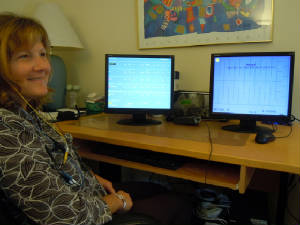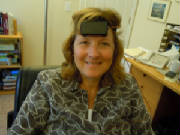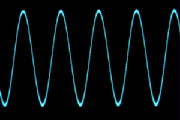|
We offer the following types of neurofeedback training and psychological
services:

|
Amplitude Training |
- With amplitude training, we select one or more areas of the brain to train. Electrodes are placed on the scalp at specific locations, in order to train specific areas of the cortex to be more or less activated. Training can be designed to increase brain wave activity in specific frequency ranges as well as to inhibit activity in other frequency ranges. For example, it might be effective to train certain sites on the cortex to improve attention, and other sites to alleviate anxiety or depression. Still other sites might be more effective in improving inhibition or sleep regulation.
|
Two-Channel Training |
- Two-channel training gives us the flexibility to train two areas of the brain at the same time,
reinforcing and inhibiting different frequencies for each brain site simultaneously. We can, therefore, treat each site
individually while providing training for the entire session at each site rather than switching the training in the middle
of the session. It also enables us to train the relationship between the sites in many ways, thereby influencing how electrical
activity at one site interacts with the activity at the other site.
|
Four-Channel Training |
- With four-channel training we can train four areas of the brain at the same time, reinforcing
and inhibiting different frequencies for each brain site simultaneously. We can train each site individually while providing
training for the entire session at each site rather than switching the training in the middle of the session. It also enables
us to train the coherence relationship between two pairs of sites at the same time, performing two coherence protocols at
the same time.
|
Coherence Training |
- The brain is a dynamic organ. No part of the brain works in isolation; each area is connected, and to some degree coordinated, with every other part. When we can gather information on the degree of connectivity of different parts of the cortex, we gain a better understanding of how the different regions are wired together and, therefore, about how closely they are working together. It is desirable for different areas of the brain to coordinate their efforts but also to maintain a degree of independence, so information is flowing smoothly but the processing of that information is not rigid or inflexible. An example of coordinated brain activity is the process of reading, in which the visual cortex, which sees the word, has to coordinate with the auditory cortex, which associates that particular combination of letters with particular sounds, and parts of the brain which store memory (recognizing whether the word looks familiar), proceses novelty (when the word is not familiar), and asssign meaning. The activity of all these brain regions have to be well timed, but they cannot be in perfect lock-step, or else there would be no flexibility in telling the difference between words that might look or sound very similar or that might have different meanings in different contexts. Another example is social functioning, in which the areas of the brain that process verrbal information or language, nonverbal information, like tone of voice, humor and facial expressions, visual information, auditory information and memory have to be coordinated. If these areas are too closely coordinated, however, the individual might respond too rigidly in social situations and might not be able to tell the subtle differences between different situations or respond differently depending on the situation.
|
Live Z-Score Training |
- With live z-score training, we gather four channels of brainwave information, recording
live from four sites of the cortex and comparing hundreds of bits of data about brain activity at the same moment to a normative
database. With the client sitting there in person, we can record information on amplitude, phase, coherence
and other aspects of brain activity and see how they compare to what is normal for an individual of the same age and
gender. We can then reinforce the patient when the majority of the factors that we are monotoring are approaching
or actually in the normal range. This is a way of training overall brain activity to be in the normal
range and a way of working with hundreds of variables at the same time.
|
Beta-Reset Training |
- Beta-reset trains the brain to respond to rapidly changing demands that might be useful in disrupting old, rigid patterns and open up the brain to process emotional information in new ways. It is being used in the retrieval and processing of painful emotional memories, sleep regulation, managing physical and medical conditions and peak performance.
|
Alpha-Theta Training |
- Alpha-Theta trains the brain to get into a state of very deep relaxation; almost a meditative state. It is used for anxiety reduction, improved visualization and creativity, peak performance training, the treatment of individuals with trauma histories, and the treatment of individuals with alcoholism and substance abuse. It is often used after a period of amplitude training.
|
Passive Infrared Hemoencephalography (pIR HEG) |

- PIR HEG is a form of neurofeedback that does not directly train the brain to increase or inhibit specific brain wave frequencies. Rather, the purpose is to increase the activation of the pre-frontal cortex. When a part of the brain becomes more activated, there is increased blood flow to that area of the brain and, as a result, more heat is generated from that region because of the increased metabolic activity. That increased heat can be measured by the amount of infrared radiation projecting from the scalp. The individual wears a headband with an infrared sensor, and the goal is to increase the amount of infrared activity that is picked up by the sensor. The more infrared activity there is, the more heat is being produced by that area of the cortex because of the increased activity of that part of the brain. The individual achieves this increased activation by watching a DVD. Whever the video pauses, the individual has to increase his or her brain activitation to get the video started again. When the infrared activity that is picked up by the sensor increases, the video restarts, and the brain is therefore trained to increase the activation of the pre-frontal cortex. The pre-frontal cortex is important for executive functioning, attention, mood and social functioning. There are also published reports on using HEG in the treament of migraine headaches.
|
Heart Rate Variability Training (HRV) |

- Chronic stress causes wear and tear on the body. The emotional tension we experience in response to life’s daily hassles accumulates in the body, resulting in symptoms like fatigue, headaches, gastrointestinal problems, anxiety, physical illness, feelings of hopelessness and helplessness, and sleep problems. This undercurrent of stress makes coping with larger problems in life more difficult. When we are chronically stressed, our heart rhythm becomes out of sync. A healthy heart rhythm, which is associated with good mental and physical health, a well-functioning nervous system, and a feeling of well-being, reflects a balance between sympathetic and parasympathetic activity. The sympathetic nervous system activates us to respond to external demands by increasing our heart rate, blood pressure, muscle tension, and other physiological processes. The parasympathetic nervous system controls those same processes in a way that decreases activation and relaxes us. When our heart rate is healthy, both processes are balanced and in sync, and our heart rate varies from peak sympathetic activity to peak parasympathetic activity.
Research has indicated that establishing and practicing certain breathing patterns can increase heart rate variability, resulting in a balance of sympathetic and parasympathetic activity that reduces the physical and emotional tolls of stress and provides greater relaxation and feelings of well-being. This can be accomplished by learning to breathe slowly and steadily from the diaphragm (or “belly breathing”), inhaling for about six seconds and exhaling for about six seconds, without holding one’s breath or straining to breathe. This is not easy to do, given that most of us have been conditioned over a lifetime of living in stress to breathe quickly and shallowly. However, help is available through computer technology that we use in our practice called HeartMath Heart Rate Variability Training (HRV). First, you are coached in practicing slow and rhythmic diaphragmatic breathing. Then, a sensor is placed on your index finger or ear lobe that monitors your heart rhythm. You then receive immediate feedback by seeing your heart rhythm patterns in real time on a computer screen. You can see when your heart rhythm is becoming more regular and consistent, and colored bars and tones inform you when you are in a zone of positive and healthy heart rhythm coherence. By using this feedback in the office and practicing the breathing techniques outside the office, you can learn to improve your heart rate variability and decrease the chronic effects of stress on your mind and your body. HRV can be used as a stress management tool by itself or in conjunction with neurofeedback training.
|
Quantitative Electroencephalogram (qEEG) |
- QEEG's are used to map the electrical activity of several sites of the cortex simultaneously. The information is digitalized and processed through a normative data base, comparing the electrical activity of the individual's brain with the brains of typical individuals of the same age. The recording gives us a map of each site of the brain that was recorded, and what the balance of electrical activity is at each site. We get to see where there is abnormal or atypical electrical activity and where there is abnormal connectivity between areas of the brain, that is, which parts of the brain are not working in synchrony with other regions. This enables us to target specific areas of the brain to train and to train in specific frequencies as specified by the brain map.
|
Psychological Testing |
- Psychological and neuropsychological testing can often provide more comprehensive information than can be gained from clinical interviews and psychotherapy. It can provide rich and comprehensive data on an individual's intelligence, cognitive abilities, academic ahcievement and learning abilities, attention, emotional issues and personality patterns. We often use psychological testing to identify an individual's correct diagnosis and develop an appropriate, realistic treatment plan. We use the data from testing to make recommendations to the individual's therapist, school and physician. Psychological testing can be useful in aiding in the diagnoses of Attention Deficit Hyperactivity Disorder, learning disabilities, Asperger's Disorder, Pervasive Developmental Disorder, Autism spectrum functioning, Bipolar Disorder, Mood Disorders and Anxiety Disorders. It can also identify cognitive problems in individuals with memory problems, dementia, brain injury and other medical diagnoses.
|
Psychotherapy |
- Psychotherapy and counseling, also known as "talk therapy," involve working with a therapist to understand and resolve emotionally troubling problems and problematic behaviors. We can work on developing better relationships with others, coping with anxiety and depression, changing habits and behavior or developing strategies to improve attention and organizational skills, to name just a few of the possibiliites. A person can be seen as an individual, or as part of a couple or a family. Psychotherapy is often integrated with the neurofeedback training to provide a comprehensive approach to therapy. We provide psychotherapy for adults, children of all ages, adolescents and families in complete confidentiality.